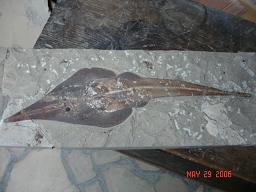Hakel
Profile Altitude:
670m
Distance from Beirut: 55km
Getting
There
From
Beirut, take the highway toward the north of Lebanon, Nahr El Kalb tunnel,
Jounieh, Jbeil, head east towards Amshit, Hbaline, Obaidat, Hakel. |

|
General Information
Perhaps the oldest continuously collected fossil locality, the
area near the towns of Hakel and Hadjula, Lebanon is known for fossil fishes.
The limestone rocks there preserve a wide variety of mid-Cretaceous fossils.
The fishes are of particular interest because the age is right to capture
early members of many of today's most common ocean fish groups, as well as
many extinct groups.
Fishes are the oldest known of the animals which have backbones - the
vertebrates. Recently they have been found in rocks from the Cambrian Period,
dating some 500 million years old. Myriad forms have evolved and disappeared
over the past 1/2 billion years, but thousands of varieties still exist in the
seas, oceans, lakes and rivers. Even with the vast variety of fishes, most,
living or extinct, can easily be classified on the basis of how much of the
skeleton is bone, and the shapes of the bones.
Chondrichthyean fishes are those with skeletons comprised
primarily of cartilage, with little real bone present. These are best typified
by the sharks. Fossils readily identifiable as sharks are first known from
mid-Paleozoic rocks. Many cartilaginous fish forms have appeared and
disappeared, to be found only as fossils, but the basic 'shark' form has
persisted nearly 400 million years.
 |
|
Osteichthyean
fishes are those with bony skeletons.
Though they first appeared soon after the sharks, they remained relatively
obscure until Mesozoic times.
Soon they diversified into the varied forms familiar to us today ranging from
angelfish, catfish, and sailfish, to minnows. |
The third layer of Lebanon limestone (about 3580 feet thick) is characterized
at the base by abundant oyster beds or by hippurite limestone (Cenoman-Turon).
One peculiarity is the slate of Hakel, containing fossil fishes.
Information From the Ministry of
Tourism

|